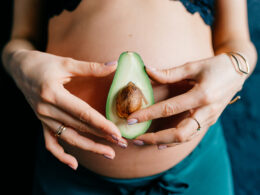My health and fertility journey are closely woven together, but my health most meaningfully changed when I made my fertility and future family my “why.”
For many years, working on my health and wellness solely for my own sake was not enough. Despite playing sports in junior high and early high school and eating a moderately healthy diet guided by my mom’s grocery choices and homemade meals, I always struggled with my weight. At one point, my weight got so bad that my parents connected me with a personal trainer, hoping that she could inspire healthy changes. But that didn’t last. My health journey ebbed and flowed as I tried new workouts and diet choices, all of which quickly felt unsustainable and fell to the wayside.
I didn’t realize at the time how my general health and my fertility health were intertwined. For many years, I was unfazed by my long and unpredictable cycles; into my college years, I would go two to five months between periods. At some point in college, my mom realized that time alone wasn’t going to help my cycles, so I met with an OB/GYN who prescribed me progesterone to “regulate my cycles.” It worked okay, though I didn’t have any personalized information about my cycles to know the best time to take it. If my memory is correct, I was told to take it for the 10 days before my next period should start. Still, it was a step in the right direction of helping me achieve normal hormone levels.
Intentionality during the single years
After graduation, I found a good job and landed in a great Catholic faith community. My hopes for marriage quickly rose to the forefront of my prayers, and I decided that it was time to take my health and fertility more seriously.
Charting my cycle
A friend who is a Creighton Method instructor taught me how to chart my cycles, and after doing a little of my own research, I was confident that I had polycystic ovary syndrome (PCOS). My symptoms of long cycles, male-pattern extra hair growth, acne, and weight issues checked all the boxes for the most common signs of PCOS. I booked an appointment at the nearby NaPro Technology clinic, and an ultrasound confirmed that my intuition was right. I was once again prescribed progesterone, but this time, I was taught to time it to my cycle.
Pursuing a healthy weight
However, there was still the issue of my weight. I knew it could be a hindrance to becoming pregnant in the future, and while I wasn’t even dating at the time, I wanted to use my single years intentionally to become a better steward of my body. I hit a breaking point when one doctor suggested I buy into a weight loss program where you only eat packaged food provided by the company to create a calorie deficit. I was almost desperate enough to try it, but it went against everything I thought I knew about health and nutrition.
Instead, I decided to try Noom, a weight loss app that encourages eating whole foods, cutting calories, increased movement, and positive thinking. And for a time, it worked! Within a few months, I shed about 35 pounds, finding myself the healthiest I had been since early high school. While I gained some weight back once I stopped the program, it was a good first step that proved I could make a difference in my health. My experience with Noom also instilled in me an insatiable curiosity about health, nutrition, and fertility, leading me to discover podcasts and other resources to feed my new interest.
Testing (and retesting) my hormone levels
During this time, I began meeting with a different NaPro doctor, who better guided me as we continued testing my progesterone levels. Each cycle, I would come in for another blood draw, and though my levels were slow to rise, requiring frequent shifts in the dosage I was taking, my doctor and I continued to see slow progress with my bloodwork and in the form of shorter, more predictable cycles. After years of silently worrying that I was doomed to struggle with infertility, or that I wouldn’t be able to carry a pregnancy to term, hope became more powerful than my fears.
Trying to conceive
God’s timing is beautiful. Around the same time that I was seeing positive results in my weight loss and progesterone supplementation journey, I began dating a wonderful guy. We got engaged about a year into our relationship and were married within two years of dating. All through this time, I kept meeting with my doctor, and my fears of struggling with infertility lessened with each visit.
Still, my husband and I knew when we married that conceiving right away was not a given. Since we were in our later 20s, we didn’t want to wait to try for kids in case getting pregnant proved to be a struggle. After a few months with no success, my doctor suggested I get tested for insulin resistance, which can be one of the underlying causes of PCOS.
Insulin resistance
Sure enough, my tests came back with mild insulin resistance. The supplement myo-inositol was added to my regimen. Again, I saw progress in achieving a more predictable cycle —I remember the joy I felt when I ovulated on the same day two cycles in a row for the first time. But I still didn’t get pregnant.
Learning that improving my health is a good in itself
During this season, I had to learn that striving for health as a woman is a good in itself, even if babies never come. It was easy to grow weary of cycle charting without a change in cycle length, and it was tempting to feel that my body was broken beyond repair. But each month was a new opportunity to take my health seriously, which takes discipline and virtue and, ultimately, trust in God.
During this season, I had to learn that striving for health as a woman is a good in itself, even if babies never come.
After six cycles of trying to conceive, my doctor reviewed my options. If nothing changed, she suggested I consider an ovarian wedge resection, which has been proven to help some women with PCOS. We could also look into fertility on my husband’s side to see if that’s where any issues were.
But first, she suggested one more medication (letrozole), which was meant to, essentially, kickstart my ovaries. To my complete shock, within one cycle, I was pregnant! We found out two days before we moved into our first house. Once again, God’s timing was beautiful.
Progesterone supplementation during pregnancy
However, with my history of low progesterone and worry about miscarriage, I immediately went to get my levels tested to see if I would need to supplement throughout my pregnancy. Sure enough, my levels were low. I tried taking progesterone orally for a while, but eventually, we moved to intramuscular injections twice a week. The dosage ebbed and flowed as the months continued, but we were able to keep both baby and me healthy. Our sweet boy was born on his due date, another pleasant surprise in our otherwise unpredictable story.
My advice to other women: Don’t wait to learn cycle charting
My biggest advice to anyone wanting to take their health and fertility journey seriously is to not wait to learn your cycle. There are so many resources available, whether personal instructors or apps, that understand the biomarkers to look for when charting your cycle. Take advantage of these resources to better know yourself and your own body.
Too often we feel disconnected from our bodies. Instead of feeling trapped by the health hurdles you face, let your body guide you on a journey of self-knowledge, which will only help you become more of who you are meant to be. As a person of faith, I found comfort through inviting God into the journey, and trusting that in the end, it is all in his hands. We can’t control our stories, but we can be responsive to his grace in the process and do the best with the knowledge we’re given.
Too often we feel disconnected from our bodies. Instead of feeling trapped by the health hurdles you face, let your body guide you on a journey of self-knowledge, which will only help you become more of who you are meant to be.
Ava Frecker is the founder and editor of Caeli (caelicatholic.com) and the former editor of Radiant magazine. She is a midwestern girl with a heart for supporting people’s stories. She’s also a Jane Austen enthusiast, chai tea addict, grammar activist, amateur sourdough baker, and gal pal to St. Thérèse — on whose feast day she married her beloved, Dominic. They now have their sweet boy, Linus. Follow her on Instagram @avalalor.











